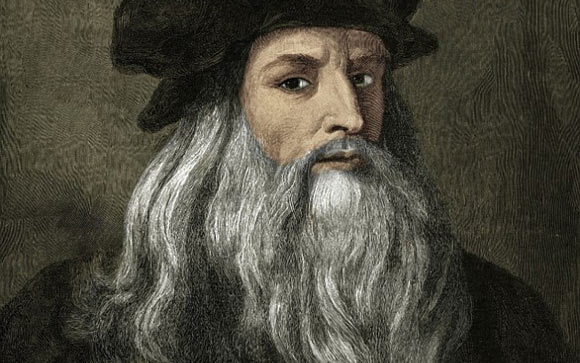Leonardo da Vinci invented “Parachute”, “Armored Car”, “Triple Barrel Canon”, “Double Hull”, “Omtihopter” and “Anemometer”
Leonardo da Vinci was one of the most famous artists, intellectuals and scientists during the Italian Renaissance. He was born in 1452 in Vinci, Italy. He was an illegitimate child born to a young peasant woman, but raised by his father and stepmothers. His birth name was “Leonardo di ser Piero da Vinci”, which means “Leonardo, son of Messer Piero from Vinci”. Little is known about his early life, other than that he was apprenticed to a famous artist known as Verrocchio in 1466 at the age of 14. There he acquired a multitude of technical skills such as the study of humanities, working with metals and leather, carpentry, drawing, sculpting, drafting, chemistry, plaster casting, mechanics and painting. It is said that Leonardo was the model for some of his master’s works such as the bronze statue of David in the Bargello and the Archangel Michael in Tobias and the Angel.
In 1472, at the age of 20, Leonardo qualified as a master artist in the guild of artists and doctors of medicine, but he remained so attached to Verrocchio that he continued to work with him even after his father established a separate business for him. He was charged with sodomy in 1476, and although acquitted, there are no public records of his life for the next two years. He produced some important works until 1481, including an altarpiece for the Chapel of St Bernard and “The Adoration of the Magi” for the Monks of San Donato a Scopeto. Between 1482 and 1499, he lived in Milan where he worked with Ludovico il Moro, the Duke of Milan. Here he again produced a number of important works such as the “Virgin of the Rocks”, “The Last Supper” for the monastery of Santa Maria delle Grazi and a massive clay horse known as the “Gran Cavallo” which was to serve as a monument to Francesco Sforza, the predecessor of Ludovico. This project, however, remained unfinished.
He returned to Florence in 1500, where he lived and was closely associated with the Servite monks at the monastery of Santissima Annunziata. In 1502 he began working for Cesare Borgia, the son of Pope Alexander VI. He was employed as a military architect and engineer and traveled the country with Cesare. His most famous painting, and possibly one of the most famous paintings in the world today, the Mona Lisa, was created between 1505 and 1507 in Florence. It was privately commissioned by a merchant, and is said to be a painting of his wife, but that is not certain. Leonardo never actually gave it to the merchant and kept it with him for the rest of his life. Today it is displayed at the Louvre Museum in Paris, encased in bulletproof glass, and considered an invaluable national possession.
Leonardo da Vinci was a polymath in the true sense of the word. His contributions to science are just as far reaching as his contribution to art. His notes and accompanying diagrams comprise more than 13,000 pages and include observations on a vast range of topics including architecture, the study of plants, rocks, human emotions, anatomy, flying machines, and drainage systems. He was also a distinguished engineer and inventor and designed a system of movable barricades to protect the city from attack. He reached the height of fame during his own life and was a favorite with the King of France, who is said to have held Leonardo in his arms on the latter’s deathbed. Da Vinci is also said to have been strikingly handsome as well as an acclaimed genius. He died at the royal manor house of the King of France on May 2, 1519 and is still remembered as an unparalleled genius, artist, and philosopher.
